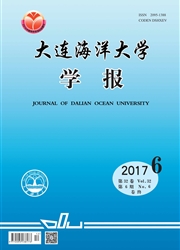

 中文摘要:
中文摘要:
在实验室条件下,进行了不同饵料模式与投喂方式对中间球海胆Strongylocentrotus intermedius性腺营养成分的影响研究。试验设置4种饵料模式(M1组投喂海带,M2组投喂海带+贻贝,M3组投喂南瓜,M4组投喂胡萝卜)和3种投喂方式(对照组投喂海带150 d,RM1组投喂南瓜75 d后投喂海带75 d,RM2组投喂胡萝卜75 d后投喂海带75 d),试验结束后,对海胆性腺中氨基酸、β-胡萝卜素和脂肪酸含量进行测定。结果表明:不同饵料模式条件下,M2组海胆性腺中氨基酸总量(TAA)、必需氨基酸总量(EAA)和EAA/TAA均最高;M4组鲜味氨基酸总量占氨基酸总量的百分比最高;M1与M2组雌、雄海胆的β-胡萝卜素含量及个体平均β-胡萝卜素含量均无差异性差异(P〉0.05),二者显著高于其他2组(P〈0.05);M3组雌海胆性腺中多不饱和脂肪酸(PUFA)含量显著高于其他3组(P〈0.05),雄海胆中PUFA含量4组间无显著性差异(P〉0.05)。不同投喂方式条件下,RM2组海胆性腺中TAA、EAA和EAA/TAA含量均最高;对照组雄海胆性腺中β-胡萝卜素含量及个体平均β-胡萝卜素含量均显著高于RM1和RM2组(P〈0.05),而雌海胆性腺中二者的含量与RM1组无显著性差异(P〉0.05),但均显著高于RM2组(P〈0.05);RM1组雌、雄海胆性腺中PUFA含量均最高。研究表明:M2组饵料模式和RM2组投喂方式均可提高海胆性腺中氨基酸含量,且M2组饵料模式对海胆个体平均β-胡萝卜素含量的提高有促进作用,M3组饵料模式和RM1组投喂方式可明显提高海胆性腺中PUFA的含量。
 英文摘要:
英文摘要:
The effects of different diets and feeding patterns on nutritional composition in gonad was studied in sea urchin Strongylocentrotus intermedius under a laboratory. The contents of total amino acid( TAA),β-carotene and fatty acid were measured in the sea urchin fed four kinds of diets( kelp in M1 group,kelp + mussel in M2 group,pumpkin in M3 group,and carrot in M4group) and by three feeding patterns( kelp for 150 days in control group,kelp for 75 days and then pumpkin for 75 days in RM1 group,and carrot for 75 days and then kelp for 75 days in RM2group). The results show that the maximal contents of TAA,and essential amino acid( EAA) and EAA / TAA value in the gonad of sea urchin were found in M2 group,and the maximal proportion of flavor amino acids in TAA was observed in M4 group. There were no significant differences in contents of the total β-carotene and individual average β-carotene in females and males in M1 and M2groups( P〉0. 05),significantly higher than those in M3 and M4groups( P〈0. 05). There was significantly higher content of polyunsaturated fatty acids( PUFA) in ovary of sea urchin in M3 group than that in the other three groups( P〈0. 05),without significant differences) in the content of PUFA in testis of sea urchin among the four groups( P〉0. 05). In the different feeding patterns,the maximal contents of TAA,EAA and EAA / TAA in the gonad of the sea urchins were observed in RM2 group. The contents of the total β-carotene and the individual average β-carotene in the gonad of the male sea urchin were significantly higher in the control group than those in RM1 and RM2groups( P〈0. 05),and there were no significant differences in the contents of the total β-carotene and the individual average β-carotene in the ovary of sea urchin in control group and RM1group( P〉0. 05). The contents of the total β-carotene and the individual average β-carotene in the testis of the sea urchin were significantly higher than that in RM2group( P〈0. 0
 同期刊论文项目
同期刊论文项目
 同项目期刊论文
同项目期刊论文
 Test and gonad characteristics in different genders of cultivated sea urchins(Strongylocentrotus int
Test and gonad characteristics in different genders of cultivated sea urchins(Strongylocentrotus int Isolation and characterization of bacteria associated with a syndrome disease of sea urchin Strongyl
Isolation and characterization of bacteria associated with a syndrome disease of sea urchin Strongyl 期刊信息
期刊信息
